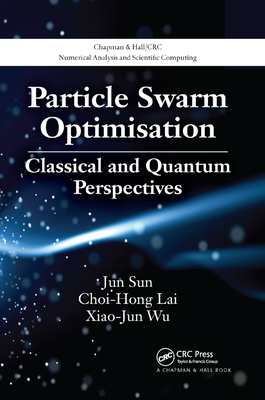Optimization of Multilayered Radar Absorbing Structures (RAS) using Nature Inspired Algorithm
暫譯: 利用自然啟發演算法優化多層雷達吸收結構 (RAS)
Joy, Vineetha, Padwal, Vishal G., Singh, Hema
- 出版商: CRC
- 出版日期: 2021-07-19
- 售價: $4,110
- 貴賓價: 9.5 折 $3,905
- 語言: 英文
- 頁數: 70
- 裝訂: Hardcover - also called cloth, retail trade, or trade
- ISBN: 0367759128
- ISBN-13: 9780367759124
-
相關分類:
Algorithms-data-structures
海外代購書籍(需單獨結帳)
相關主題
商品描述
Stealth technology is a crucial pre-requisite in the combat zone, where swiftness, surprise and initiative are the decisive elements for survivability. The supreme goal here is to reduce the visibility of military vehicles by shaping, application of radar absorbing materials, passive cancellation, active cancellation etc. With respect to multilayered radar absorbing structures (RAS), this book presents an efficient algorithm based on particle swarm optimization (PSO), for the material selection as well as optimization of thickness of multilayered RAS models considering both normal as well as oblique incidence cases. It includes a thorough overview of the theoretical background required for the analysis of multilayered RAS as well as the step-by-step procedure for the implementation of PSO-based algorithm. The accuracy and computational efficiency of the indigenously developed code is also clearly established using relevant validations and case studies.
FEATURES
- Provides step-by-step procedure for the implementation of particle swarm optimization (PSO) based algorithm in the context of multilayered radar absorbing structures (RAS) design
- Helps to understand the EM design, analysis and optimization of multilayered RAS
- Describes the theoretical background required for the analysis of multilayered RAS
- Illustrates in detail the theoretical formulation supported by intuitive ray diagrams and comprehensive flowcharts to implement the algorithm with ease
- Includes elaborate validations and case studies
This book will serve as a valuable resource for students, researchers, scientists, and engineers involved in the electromagnetic design and development of multi-layered radar absorbing structures.
商品描述(中文翻譯)
隱形技術在戰鬥區域中是一個關鍵的前提條件,迅速、驚奇和主動性是生存的決定性因素。這裡的最高目標是通過形狀設計、應用雷達吸收材料、被動消除、主動消除等方法來降低軍事車輛的可見性。關於多層雷達吸收結構(RAS),本書提出了一種基於粒子群優化(PSO)的高效算法,用於材料選擇以及考慮正常和斜入射情況下多層RAS模型的厚度優化。它包括對多層RAS分析所需的理論背景的全面概述,以及基於PSO算法實施的逐步程序。通過相關的驗證和案例研究,清楚地確立了本土開發代碼的準確性和計算效率。
特點
- 提供多層雷達吸收結構(RAS)設計中基於粒子群優化(PSO)算法實施的逐步程序
- 幫助理解多層RAS的電磁設計、分析和優化
- 描述多層RAS分析所需的理論背景
- 詳細說明理論公式,並輔以直觀的光線圖和全面的流程圖,以便輕鬆實施算法
- 包含詳細的驗證和案例研究
本書將為參與多層雷達吸收結構的電磁設計和開發的學生、研究人員、科學家和工程師提供寶貴的資源。
作者簡介
Mrs. Vineetha Joy is working as Scientist at Centre for Electromagnetics of CSIR-National Aerospace Laboratories, Bangalore, India since March, 2016. She obtained B. Tech in Electronics and Communication Engineering with Second Rank from University of Calicut in 2011 and received M. Tech degree with First Rank in RF & Microwave Engineering from Indian Institute of Technology (IIT), Kharagpur in 2014. She is actively involved in various R&D programs spanning domains like Computational Electromagnetics, Electromagnetic Design and Performance Analysis of Radomes, Design and Development of broadband radar absorbing structures (RAS), Hybrid Numerical Techniques for Scattering Analysis, and Electromagnetic Characterization of Potential Materials for Airborne Structures. She has authored/co-authored over 100 research publications including one book, peer reviewed journal papers, symposium papers, technical documents and test reports.
Mr. Vishal G. Padwal obtained M. E. in Electronics and Tele-communication (Microwave) in 2017 from Department of Electronics & Tele-communication Engineering, Pune Institute of Computer Technology, India and B.E. in Electronics & Tele-communication Engineering from University of Pune, India. He is currently working as Research Scientist at Society for Applied Microwave Electronics Engineering & Research (SAMEER), Mumbai. During 2018-2019, he was working as Project Assistant at Centre for Electromagnetics of CSIR-National Aerospace Laboratories, Bangalore, India. His research interest includes EM design and analysis of Multi-layered Radar Absorbing Structures, Optimization Techniques, Computational Electromagnetics, etc. He has co-authored several conference papers, technical documents and test reports.
Dr. Hema Singh is working as Senior Principal Scientist in Centre for Electromagnetics, National Aerospace Laboratories (CSIR-NAL), Bangalore, India. She has received Ph.D. degree in Electronics Engineering from IIT-BHU, Varanasi India in Feb. 2000. For the period 1999-2001, she was Lecturer in Physics at P.G. College, Kashipur, Uttaranchal, India. She was a Lecturer in EEE of Birla Institute of Technology & Science (BITS), Pilani, Rajasthan, India, for the period 2001-2004. She joined CSIR-NAL as Scientist in January 2005. Her active area of research are Computational Electromagnetics for Aerospace Applications, EM analysis of propagation in an indoor environment, Phased Arrays, Conformal Antennas, Radar Cross Section (RCS) Studies including Active RCS Reduction. She has contributed in the projects not only sponsored by DRDO on low RCS phased array, Active RCS reduction, RAS development, but also in the project sponsored by Boeing USA on EM analysis of RF field build-up within Boeing 787 Dreamliner, She received Best Woman Scientist Award in CSIR-NAL, Bangalore for period of 2007-2008 for her contribution in the area of active RCS reduction. Dr. Singh co-authored 14 books, 2 book chapters, 7 software copyrights, 370 scientific research papers and technical reports.
Dr. Raveendranath U. Nair is working as Senior Principal Scientist & Head in Centre for Electromagnetics, National Aerospace Laboratories (CSIR-NAL), Bangalore, India. He holds a Ph.D. degree in Microwave Electronics from MG University, India. He has over 20 years' experience in the field of electromagnetic design and analysis of radomes, design and development of FSS based structures for airborne platforms, radar cross section (RCS) studies, design and development of artificially engineered materials etc. He has contributed significantly to the National Radome Programs including Doppler Weather Radar (DWR) radome installed at SHAAR Sreeharikota, Fire Control Radar (FCR) radome for Jaguar aircraft, Astra missile ceramic radome, nosecone radome for Saras aircraft, multiband radomes for TU-142M aircraft etc. He has authored/co-authored over 200 research publications including peer reviewed journal papers, symposium papers, technical reports, and two books.
作者簡介(中文翻譯)
維尼莎·喬伊女士自2016年3月以來在印度班加羅爾的CSIR國家航空實驗室電磁學中心擔任科學家。她於2011年在卡利卡特大學獲得電子與通信工程的B. Tech學位,並以第二名的成績畢業,2014年在印度理工學院(IIT)卡哈爾古爾獲得射頻與微波工程的M. Tech學位,並以第一名的成績畢業。她積極參與各種研發計劃,涵蓋計算電磁學、雷達罩的電磁設計與性能分析、寬頻雷達吸收結構(RAS)的設計與開發、散射分析的混合數值技術,以及潛在材料的電磁特性分析等領域。她已發表或共同發表超過100篇研究出版物,包括一本書、同行評審的期刊論文、研討會論文、技術文件和測試報告。
維沙爾·G·帕德瓦爾先生於2017年在印度普納計算機技術學院電子與電信工程系獲得電子與電信(微波)碩士學位,並在印度普納大學獲得電子與電信工程的學士學位。他目前在印度孟買的應用微波電子工程與研究協會(SAMEER)擔任研究科學家。在2018年至2019年間,他在印度班加羅爾的CSIR國家航空實驗室電磁學中心擔任項目助理。他的研究興趣包括多層雷達吸收結構的電磁設計與分析、優化技術、計算電磁學等。他共同發表了幾篇會議論文、技術文件和測試報告。
海瑪·辛格博士在印度班加羅爾的CSIR國家航空實驗室電磁學中心擔任高級首席科學家。她於2000年2月在印度瓦拉納西的IIT-BHU獲得電子工程的博士學位。在1999年至2001年間,她在印度烏塔拉坎德的卡希普爾研究生學院擔任物理講師。2001年至2004年間,她在印度拉賈斯坦的比爾拉科技與科學學院(BITS)擔任電子與電氣工程講師。她於2005年1月加入CSIR-NAL擔任科學家。她的主要研究領域包括航空應用的計算電磁學、室內環境中的傳播電磁分析、相控陣列、符合性天線、雷達截面(RCS)研究,包括主動RCS減少。她參與的項目不僅包括由DRDO贊助的低RCS相控陣列、主動RCS減少、RAS開發項目,還包括由美國波音公司贊助的關於波音787夢幻客機內部RF場建立的電磁分析項目。她因在主動RCS減少領域的貢獻而獲得2007至2008年度CSIR-NAL最佳女性科學家獎。辛格博士共同發表了14本書、2章書籍、7項軟體著作權、370篇科學研究論文和技術報告。
拉維恩德拉納特·U·奈爾博士在印度班加羅爾的CSIR國家航空實驗室電磁學中心擔任高級首席科學家及負責人。他擁有印度MG大學的微波電子學博士學位。他在雷達罩的電磁設計與分析、為空中平台設計與開發基於FSS的結構、雷達截面(RCS)研究、人工工程材料的設計與開發等領域擁有超過20年的經驗。他對國家雷達罩計劃做出了重要貢獻,包括安裝在SHAAR Sreeharikota的多普勒氣象雷達(DWR)雷達罩、為美洲獅飛機設計的火控雷達(FCR)雷達罩、阿斯特拉導彈的陶瓷雷達罩、薩拉斯飛機的鼻錐雷達罩、TU-142M飛機的多頻段雷達罩等。他已發表或共同發表超過200篇研究出版物,包括同行評審的期刊論文、研討會論文、技術報告和兩本書。











